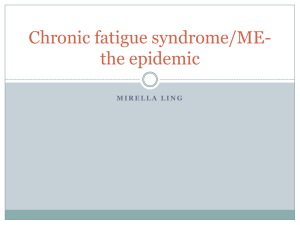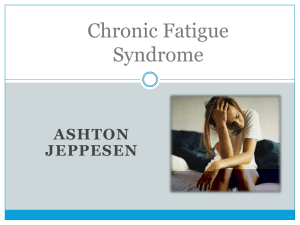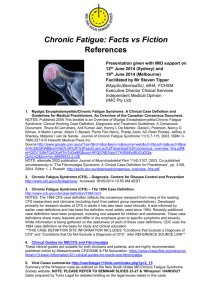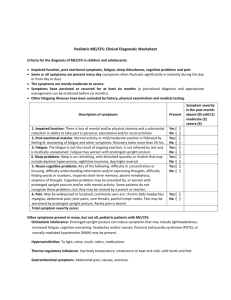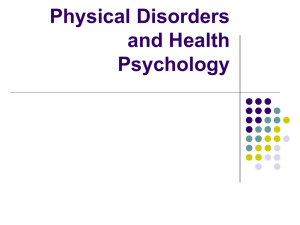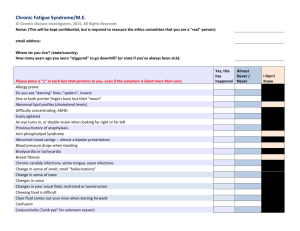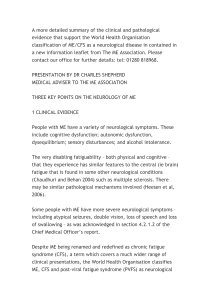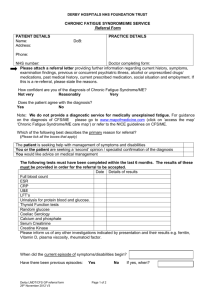Cardiorespiratory Responses to Exercise in Female Chronic Fatigue
advertisement
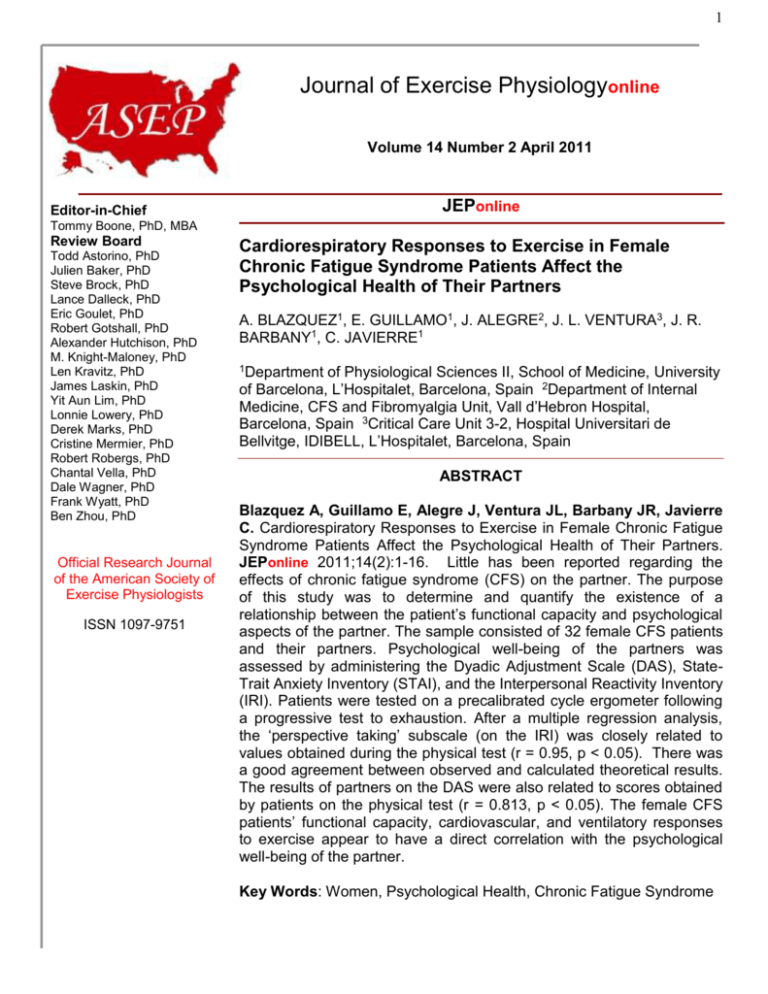
1 Journal of Exercise Physiologyonline Volume 14 Number 2 April 2011 JEPonline Editor-in-Chief Tommy Boone, PhD, MBA Review Board Todd Astorino, PhD Julien Baker, PhD Steve Brock, PhD Lance Dalleck, PhD Eric Goulet, PhD Robert Gotshall, PhD Alexander Hutchison, PhD M. Knight-Maloney, PhD Len Kravitz, PhD James Laskin, PhD Yit Aun Lim, PhD Lonnie Lowery, PhD Derek Marks, PhD Cristine Mermier, PhD Robert Robergs, PhD Chantal Vella, PhD Dale Wagner, PhD Frank Wyatt, PhD Ben Zhou, PhD Official Research Journal of the American Society of Exercise Physiologists ISSN 1097-9751 Cardiorespiratory Responses to Exercise in Female Chronic Fatigue Syndrome Patients Affect the Psychological Health of Their Partners A. BLAZQUEZ1, E. GUILLAMO1, J. ALEGRE2, J. L. VENTURA3, J. R. BARBANY1, C. JAVIERRE1 1Department of Physiological Sciences II, School of Medicine, University of Barcelona, L’Hospitalet, Barcelona, Spain 2Department of Internal Medicine, CFS and Fibromyalgia Unit, Vall d’Hebron Hospital, Barcelona, Spain 3Critical Care Unit 3-2, Hospital Universitari de Bellvitge, IDIBELL, L’Hospitalet, Barcelona, Spain ABSTRACT Blazquez A, Guillamo E, Alegre J, Ventura JL, Barbany JR, Javierre C. Cardiorespiratory Responses to Exercise in Female Chronic Fatigue Syndrome Patients Affect the Psychological Health of Their Partners. JEPonline 2011;14(2):1-16. Little has been reported regarding the effects of chronic fatigue syndrome (CFS) on the partner. The purpose of this study was to determine and quantify the existence of a relationship between the patient’s functional capacity and psychological aspects of the partner. The sample consisted of 32 female CFS patients and their partners. Psychological well-being of the partners was assessed by administering the Dyadic Adjustment Scale (DAS), StateTrait Anxiety Inventory (STAI), and the Interpersonal Reactivity Inventory (IRI). Patients were tested on a precalibrated cycle ergometer following a progressive test to exhaustion. After a multiple regression analysis, the ‘perspective taking’ subscale (on the IRI) was closely related to values obtained during the physical test (r = 0.95, p < 0.05). There was a good agreement between observed and calculated theoretical results. The results of partners on the DAS were also related to scores obtained by patients on the physical test (r = 0.813, p < 0.05). The female CFS patients’ functional capacity, cardiovascular, and ventilatory responses to exercise appear to have a direct correlation with the psychological well-being of the partner. Key Words: Women, Psychological Health, Chronic Fatigue Syndrome 2 INTRODUCTION Chronic fatigue syndrome (CFS) is a clinical entity characterized by chronic disabling fatigue of at least six-months duration and several symptoms (21,39,44,49), including musculoskeletal pain, neurocognitive disorders (19,55,69,71), sleep disturbances, and exercise intolerance (5,37). Its current prevalence among adults varies between 0.23% and 0.42%, and it tends to affect people between 20 and 40 years of age. It is also more common in women; the ratio with respect to men is around 75% (29,49,51). Patients with CFS may have a number of comorbidities that worsen their prognosis and quality of life. The more common medical conditions include sicca syndrome, irritable bowel syndrome, autonomic dysfunction, and fibromyalgia (FM). This has a large impact on the family system, self-rated health (45,68), and difficulties in performing daily activities. Studies using the Short Form-36 Health Survey (SF-36) report that CFS patients have lower scores on all physical subscales compared to a healthy sample (70) and other groups of patients, indicating a marked disability and a reduced functional capacity (13,27,65). Indeed, numerous studies have demonstrated the significant impact of CFS on patients’ quality of life (1,24,50). However, the impact of the disease on the partner, as a caregiver, has not been quantified or measured. The partners of patients with a chronic illness have to cope with a reduced quality of life (10,54). They may feel disoriented (11), isolated, and abandoned (32). They may also have an increased risk of injury (26) and increased mortality (3). Headaches, abnormal heart rate (47), and weight loss (51) have all been reported in partner of patients with a chronic illness. Psychological symptoms such as anxiety (14,40), muscle tension, depressive symptoms, and widespread concern (43) may also be present. As for the emotional well-being of the partners, this is largely determined by the type of care needed for the patients (73). Partners of patients with sensory-motor impairment are probably more optimistic than are partners of patients with not only motor impairment but also sensory-cognitive deficits (20), as in the case of CFS. The need to combine work outside the home with caring for the patient who remains there can lead to stress (41), decreased leisure time (51) and feeling tired and unable to cope with the situation (10,34). This disease of unknown etiology has the characteristics of any chronic illness, but its effects are heightened by the lack of specific diagnostic tests, treatments, and the impact it has on functional ability. Its impact on the partner can be considerable. The purpose of this study was to examine the extent to which there is a relationship between the patients’ functional capacity and psychological aspects of the partners. In the event that such a relationship is identified, it will also be quantified. METHODS Participants The sample comprised a group of 32 female CFS patients and their corresponding 32 partners. The 32 patients were aged 40.3 ± 6.7 years, with a height of 1.62 ± 0.06 m and weight of 65.3 ± 13.6 kg. All the women met CDC criteria (28) for CFS and, in all cases the diagnosis was confirmed by consensus of two physicians. All patients had to meet the following inclusion criteria: (a) diagnosis made at least one year previously; (b) age between 25 and 50; and (c) having been in a stable relationship for at least two years (i.e., living together with a partner, sharing financial responsibilities and maintaining sexual relations; married status was not required). Overall, 81.3% were married and 18.7% single (Table 1). The research protocol was approved by the relevant institutional ethics committee and written informed consent was obtained from all participants. 3 Table 1. Epidemiological parameters of the patient group Married 81.3% Single 18.7% Unskilled worker 31.2 % Skilled worker 37.5 % Administration 21.9 % Profession 6.3 % Craftswoman 3.1 % College/University 28.1 % High school 40.6 % School graduate 21.9 % Elementary school 9.4 % Currently employed 21.9 % Sick leave 34.4 % Unemployed 18.7 % Marital status Profession Education Employment status Total 3.1 % Absolute 21.9 % Permanent invalidity Involved in litigation 34.4 % Pain duration (years) 11.7 ± 8.2 (range 1, 34) Initiation age (years) 28.8 ± 9.4 (range 7, 45) Fatigue duration (years) 11.4 ± 8.5 (range 3, 36) Initiation age (years) 29.1 ± 10.0 (range 7, 45) Pain Fatigue Measures Psychological parameters were assessed by administering the following scales and inventories to the partners: Interpersonal Reactivity Index (IRI) (16,17,46): The Interpersonal Reactivity Index is comprised of 28 items (seven items on each of its four dimensions), and is a measure of dispositional empathy, taking as its starting point the notion that empathy consists of a set of separate but related constructs. The instrument contains four seven-item subscales, each tapping a separate facet of empathy. The perspective taking (PT) scale measures the reported tendency to spontaneously adopt the psychological point of view of others in everyday life ("I sometimes try to understand my friends better by imagining how things look from their perspective"). The empathic concern (EC) scale assessed the 4 tendency to experience feelings of sympathy and compassion for unfortunate others ("I often have tender, concerned feelings for people less fortunate than me"). The personal distress (PD) scale determined the tendency to experience distress and discomfort in response to extreme distress in others ("Being in a tense emotional situation scares me"). The fantasy (FS) scale measured the tendency to imaginatively transpose oneself into fictional situations ("When I am reading an interesting story or novel, I imagine how I would feel if the events in the story were happening to me"). On all items, higher scores indicated greater importance of the quality specified. Dyadic Adjustment Scale (DAS) (48,59,60): The 32-item DAS is one of the most widely used instruments in studies on couples and families (58). It includes four subscales: (a) dyadic consensus; (b) dyadic satisfaction; affective expression; and (d) dyadic cohesion. The scores are calculated by adding the direct score on each item (32 in total). Higher scores indicate greater marital satisfaction. State-Trait Anxiety Inventory (STAI) (62): The STAI has 40 items (20 on each subscale). It is designed to measure both anxiety as a stable dimension of personality (trait) and anxiety behavior in the context of the patient’s current situation (state). The STAI has demonstrated its utility for measuring trait and state anxiety in patients with fatigue (31,57,66). Higher scores indicate more anxiety. All patients and partners who were approached agreed to participate and complete the psychological and physiological tests. No subjects dropped out of the study. All spouses agreed to participate but none came to the Unit in order to finish the tests. Partner tests were therefore done at home during the week following the patient’s physical test. Laboratory Exercise Tests: Exercise testing was done in the Department of Physiological Sciences at a room temperature of 22 to 24 ºC and relative physical humidity of 55 to 65%. Subjects were instructed not to perform any intensive physical activity during the 72 h prior to testing. All tests were conducted in the morning after a light breakfast. The participants were tested on a precalibrated cycle ergometer (Excalibur, Lode, Groningen, The Netherlands). They followed a progressive exercise schedule which increased in ramp by 20 W every minute up to exhaustion, which was the maximal test. After a recovery period of 4 min, they performed a personalized supramaximal test, initially without load. The workload was then increased in ramp every 30 sec by a load corresponding to the maximal value achieved in the previous test (maximal test), up to exhaustion (e.g., If the subject achieved 50 W in the maximal test, then the workload would increase 50 W every 30 sec in the supramaximal test. At 30 sec it would reach 50 W, at 60 sec 100 W, at 90 sec 150 W, etc). Oxygen uptake and CO2 production were measured by an automatic gas analysis system (Metasys TR-plus, Brainware SA, La Valette, France) equipped with a pneumotach and making use of a twoway mask (Hans Rudolph, Kansas, USA). Gas and volume calibrations were performed before each test, according to the manufacturer’s guidelines. Age-based predicted values for VO2 max were calculated from regression equations derived from maximal testing in a cohort of healthy sedentary women (VO2 max in mL·kg-1·min-1 = 42.3 - [0.356 · age in years]) (12). Heart rate (HR) was monitored continuously using a pulsometer (Polar Accurex Plus, Polar Electro OY, Finland). Arm blood pressure (BP) was taken manually using a clinical sphygmomanometer (model Erkameter 3000, Erka, Bad Tölz, Germany). The rate of perceived exertion (RPE) was also measured (7). Statistical Analysis The Kolmogorov-Smirnov test was used to establish the normal distribution of the different variables. The correlation between the different psychological test scores (DAS, STAI and IRI) of partners and the results of the patients’ exercise test were analysed using the bivariate Pearson correlation test. 5 After observing the linear relationship between variables that were statistically significant, multiple regression was applied in order to evaluate the influence of the physical test results of patients that were statistically related to scores obtained on the psychological tests completed by partners. This involved estimating the coefficients of the linear equation, involving one or more independent variables (parameters of the patients’ physical test), which best predicted the value of the dependent variable (psychological scores of partners). Data are expressed as mean ± SD. Statistical significance was set at p <0.05. All analyses were performed using SPSS vs.16 (SPSS Inc., Chicago, USA). RESULTS Psychological Tests of Partners (Table 2) The results of psychological tests administered to the partners showed that their scores on the IRI subscales ‘fantasy’ (12.8 ± 4.1), ‘personal distress’ (14.0 ± 3.2), ‘perspective taking’ (16.4 ± 2.2) and ‘empathic concern’ (17.8 ± 2.7) were similar to the average expected for men (16). The normative sample on married couples for the DAS (114.8 ± 17.8) showed that the results of partners (112.9 ± 17.5) were similar to the reference population. On the STAI, the subscale scores of partners for state anxiety (24.3 ± 4.0) and trait anxiety (25.8 ± 4.0) were low given the range of scores (20-80) (62). Table 2. Psychological tests given to partners of patients mean ±SD Interpersonal Reactivity Inventory (IRI) Fantasy 12.8 ± 4.1 Personal distress 14.0 ± 3.2 Perspective taking 16.4 ± 2.2 Empathic concern 17.8 ± 2.7 Dyadic Adjustment Scale (DAS) DAS total score Dyadic consensus 112.9 ± 17.5 50.8 ± 10.5 Affectional expression 7.9 ± 2.8 Dyadic satisfaction 40.3 ± 4.9 Dyadic cohesion 13.9 ± 4.9 State-Trait Anxiety Inventory (STAI) State Anxiety 24.3 ± 4.0 Trait Anxiety 25.8 ± 4.0 Physical Test of Patients Patients showed a low functional capacity compared to the general population of reference, with an oxygen consumption peak of 15.6 ± 6.1 mL·kg-1·min-1, 56% of the theoretical maximum. The maximal load reached was 74.3 ± 28.0 W. Maximal HR achieved was 128.8 ± 23.2 beats · min-1 (Table 3). 6 Table 3. Physiological parameters at rest, maximal, and supramaximal effort on the cycle ergometer in the patient group. Functional parameters Rest Workload (watts) Maximal Supramaximal 74.3 ± 28.0 125.8 ± 47.2 Rf (breaths·min-1) 17.5 ± 3.0 27.1 ± 6.3 26.1 ± 8.0 VE (BTPS) (L·min-1) 9.9 ± 2.3 33.5 ± 13.8 31.4 ± 12.5 0.532 ± 0.176 1.124 ± 0.425 1.101 ± 0.324 5.1 ± 1.2 15.6 ± 6.1 14.6 ± 4.9 0.312 ± 0.078 0.980 ± 0.363 0.918 ± 0.258 0.81 ± 0.08 0.97 ± 0.17 0.86 ± 0.13 0.257 ± 0.084 0.960 ± 0.427 0.796 ± 0.247 FEO2 (%) 17.1 ± 0.5 17.2 ± 0.9 17.2 ± 0.9 FECO2 (%) 3.3 ± 0. 5 3.5 ± 0.7 3.2 ± 0.7 TRUE O2 (%) 3.9 ± 0.5 3.7 ± 1.0 3.8 ± 1.0 ERO2 31.8 ± 4.7 35.4 ± 13.4 34.4 ± 11.3 ERCO2 39.3 ± 6.5 36.2 ± 8.5 39.3 ± 8.4 HR (beats·min-1) 88,7 ± 11,8 128.8 ± 23.2 125.8 ± 19.4 3.7 ± 1.0 7.5 ± 2.4 7.4 ± 2.0 SBP (mmHg) 120,1 ± 16,9 131.7 ± 17.7 131.8 ± 20.1 DBP (mmHg) 76.0 ± 13.6 77.5 ± 14.2 73.6 ± 13.0 PETO2 (mmHg) 105.3 ± 13.7 112.8 ± 7.7 111.9 ± 7.5 PETCO2 (mmHg) 33.6 ± 4.9 33.5 ± 6.4 31.4 ± 5.2 Borg Test (RPE) 9.5 ± 3.2 18.1 ± 2.3 18.5 ± 1.6 VT (L·min-1) VO2 (mL·kg-1·min-1) VO2 (L·min-1) RQ VCO2 (L·min-1) O2 Pulse Note: (Rf : Respiratory frequency; VE (BTPS): Ventilation; VT: Tidal Volume; VO2: O2 uptake; VO2:O2 uptake respect to body weight ; RQ: Respiratory Quotient; VCO2: CO2 production; FEO2:fraction of O2 in expired air; FECO2: fraction of CO2 in expired air; TRUE O2: fraction of O2 uptake; ERO2: respiratory equivalent for oxygen; ERCO2: respiratory equivalent for CO2; HR: Heart Rate; O2 Pulse: oxygen uptake divided by the heart rate; SBP: systolic blood pressure; DBP: diastolic blood pressure; PETO2: End-tidal PO2; PETCO2: End-tidal PCO2; RPE: rating of perceived exertion). Relationship between Psychological Scores and Physiological Parameters The IRI scores of the partners revealed that ‘perspective taking’ was closely related to the patients’ performance on the physical test (r = 0.95, p < 0.05). The most influential factors consistent of the following: (a) ERCO2 (respiratory equivalent for CO2) on the maximal test (-7.71); (b) FECO2 (fraction of CO2 in expired air) on the maximal test (-5.75); (c) ERCO2 on the supramaximal test (5.41); and (d) ERO2 (respiratory equivalent for oxygen) on the supramaximal test (-5.00) (Table 4). This important 7 interaction showed a strong agreement between the theoretical values derived from the exercise test and the actual observed ones (Figure 1). The ‘fantasy’ score of partners showed a statistically significant relationship with some of the values observed during the physical test (r = 0.651, p < 0.05), the most influential factors are FECO2 (1.06) and TRUE O2 (fraction of O2) (0.60); all at rest (Table 4). Table 4. The relationship between certain psychological factors and the patient’s functional capacity. Fantasy (IRI) DAS total score (DAS) Perpective taking (IRI) SC SC State Anxiety (STAI) SC SC FEO2 rest 1.06 FEO2 rest 1.40 VE (BTPS) max -0.51 Time max FECO2 rest 0.18 FECO2 rest 1.03 FECO2 max -5.75 Rf TRUE O2 rest 0.60 TRUE O2 rest 0.63 TRUE O2 max 2.92 VO2 /kg max HR rest 0.21 ERO2 rest 0.37 ERO2 max 4.90 DBP max O2 Pulse rest -0.08 SBP rest -0.36 ERCO2 max -7.71 SBP rest -0.35 VO2 supramax -0.38 PETO2max 0.56 VCO2 supramax -0.58 PETCO2 max 0.39 FECO2 supramax -1.48 VE (BTPS) supramax 0.13 ERCO2 supramax -1.09 VT supramax 0.15 O2 Pulse supramax 0.71 RQ supramax 4.66 FECO2 supramax -2.39 TRUE O2 supramax 4.41 ERO2 supramax -5.00 ERCO2 supramax 5.41 SBP 0.16 PETO2 supramax -0.64 RPE supramax -0.26 r=0.651 p<0.05 r=0..813 p<0.05 max -0.39 0.11 0.11 -0.34 r = 0.596 p<0.05 r = 0.948 p<0.05 Note: Standardized coefficients (SC), correlation (r) and statistical significance (p) (Rf : Respiratory frequency; VEBTPS: Ventilation; VT: Tidal Volume; VO2: O2 uptake; VO2 /kg: O2 uptake respect to body weight ; RQ: Respiratory Quotient; VCO2:CO2 production; FEO2: fraction of O2 in expired air; FECO2: fraction of CO2 in expired air; TRUE O2: fraction of O2 uptake; ERO2: respiratory equivalent for oxygen; ERCO2: respiratory equivalent for CO2; HR: Heart Rate; O2 Pulse: oxygen uptake divided by the heart rate; SBP: systolic blood pressure; DBP: diastolic blood pressure; PETO2: End-tidal PO2; PETCO2: End-tidal PCO2; RPE: rating of perceived exertion) (rest: values measured in rest; max: values measured in maximal test; supramax: values measured in supramaximal test). The DAS total score of partners was related to the results obtained by the patients on the physical test (r = 0.813, p < 0.05), the most influential factors being FECO2 on the supramaximal test (-1.48), FEO2 (fraction of O2 in expired air) at rest (1.40), ERCO2 on the supramaximal test (-1.09), and FECO2 8 at rest (1.03) (Table 4). On the STAI, state anxiety (r = 0.596, p = 0.036) showed a dependence on the patient’s functional capacity, it being related only to the test at rest and the test duration (-0.39) (Table 4). DISCUSSION This study indicates that the functional capacity as well as the cardiovascular and ventilatory responses to exercise of female CFS patients, assessed by a maximal exercise test, has a clear influence on the scores obtained by their partners on psychological tests (IRI, DAS and STAI). The physical test with cardiovascular and ventilatory monitoring assessed the maximum peak oxygen consumption, which is considered a reference value for determining the functional capacity of a given patient. Previous studies have shown a decrease in adaptations to submaximal efforts (23), with a decline in maximal aerobic power in patients with CFS (30, 63), even to 50% of that observed in the reference population. This was the case of the 32 female patients in the present study. A reduced functional capacity has a direct impact on the possibility of performing usual daily activities. In the group studied the maximal effort achieved could be quantified as 3-4 METS, which suggests that these patients would require the involvement of the family network and, specifically, of the partner. However, no CFS research has yet assessed the possible effects of the patient’s functional capacity, as measured by a physical test, on the couple relationship. Indeed, the relevance of the couple has rarely been studied in the literature on CFS, although it has been shown in other chronic diseases that when a patient’s pathology is associated with fatigue, the impact on partners’ personal and social lives is high (2). Most CFS patients show greater dependence in practical daily aspects, especially with respect to their family network (42). However, while the patients’ own reactions to their symptoms have been recognized and studied in the context of CFS (18,42), the beliefs and responses of relatives, as well as the perception and reaction of the patient has received little attention. The last two decades of psychophysiology research in couples have produced results that indicate a dissatisfaction (and even divorce) associated with broad-based patterns of autonomic reactivity (e.g., increased electrodermal response and heart rate) during marital interactions. This discovery, by pioneers including John Gottman (1993;22), Robert Levenson and colleagues (1994;38), and others (25,56), have led the field of psychology to two provocative conclusions: (a) Physical and psychological well-being are much more related than previously thought; and (b) Interpersonal relationships are important in the context of physical and psychological health in adults. A central component of this model is the notion that interpersonal (i.e., satisfaction with the partner) and intrapersonal (i.e., personality) characteristics play a role in the gradation of psychophysiological reactivity, which has long-term implications for physical health (35,53). Several prospective longitudinal studies suggest that marital stress is related to the results of self-reported health. One of the most extensive investigations assessed the marital quality and symptoms of illness in 364 wives and husbands over a period of four years (72). Participants with higher initial levels of marital quality reported fewer symptoms of physical illness at baseline. Moreover, improvements in marital quality during the four-year period were accompanied by fewer self-reports of symptoms of physical illness. Among 174 patients with renal disease being treated with haemodialysis, higher dyadic satisfaction was associated with a 29% reduction in mortality risk, while lower satisfaction in the relationship was associated with a 46% higher risk of mortality over a three-year follow-up period (36). 9 In the present study the IRI results showed a direct relationship between various physiological parameters and the ‘perspective taking’ subscale (as stated above, this subscale measures the reported tendency to spontaneously adopt the psychological point of view of others in everyday life, for example, between the couple). This relationship was observed for the values obtained on both the maximal and supramaximal tests. The most influential factors during the maximal test were the ERCO2 and FECO2. It seems that a less effective ventilatory response regarding the CO2 elimination with respect to ventilation during exercise is associated with a higher ‘perspective taking’ score. One explanation for this could be that repeated situations in which this adaptation worsens would lead the partner to show increased ‘perspective taking’ (i.e., involvement) as regarding the patient’s pathology. The relationship was different for the supramaximal test. In this case, during a short-term effort, lower ventilatory response for CO2 elimination with respect to ventilation was associated with lower scores on perspective taking (PT). A possible explanation here could be that the more the patient verbalizes her physical symptoms the more perspective taking is shown by the partner. Thus, the partner, in an attempt to understand his wife, could have an added source of stress, especially in relation to patients who are prone to catastrophizing (or excessively magnifying) in verbal exchanges about their overall health. Catastrophizing pain, marital dissatisfaction, and depression are important factors that affect the perception of the partner’s responses to pain (6,64). By contrast, in relation to patients with better functional adaptation, partners would show less perspective taking and less stress. Other authors have shown that social stressors can determine the magnitude of physiological activation (8). Tobe and his colleagues demonstrated that psychosocial factors may influence the development of early hypertension in a study of 248 males and females (67). Similar findings were reported in a child population, where interpersonal stress was reduced as a result of exercise and an improvement in functional capacity (52). The relationship between the physical test parameters and the results observed on the IRI subscale is very strong and shows a very low dispersion (Figure 1). This finding is even more striking if one considers that the researchers who conducted the psychological examination did so at a different time to the physical test, that the physical test was carried out by different researchers, and that those responsible for the final evaluation of the results had no direct contact with patients or their partners. This approach would seem to ensure the consistency of the results. Although chronic fatigue is heterogeneous and complex in terms of its clinical manifestations, the fact that the test was performed under strict methodological and repetitive conditions allowed us to obtain consistent and valid results which could then be subsequently evaluated in regards to the relationship to the findings obtained from the partners’ psychological tests. The DAS also showed a relationship with functional assessment, in this case with physiological values during rest and under supramaximal effort. On the supramaximal test, higher ERCO 2 and FECO2 were associated with lower scores on the DAS. It seems reasonable to suppose that the influence between the DAS and functional capacity could work in both directions. Better functioning in the couple could lead to more appropriate ventilatory adaptation at rest, and also in the supramaximal test performed after a maximum effort. To summarize, the present study has demonstrated the importance of the interaction between the symptoms of the CFS patient, specifically her functional capacity, and her partner. The sample of 32 couples is larger than that used in many studies and the quantification of functional capacity has enabled us to determine more rigorously its relationship to psychological aspects of partners. In this context, it should be acknowledged that just as functional capacity could have an impact on the couple. On a practical level, targeted therapies should therefore be introduced to enhance these aspects in the couple and help partners to provide better support and care to patients. Over the past 10 30 years, dozens of clinical trials have demonstrated the effectiveness of couple therapy in improving partner satisfaction (4,15). Although these studies cannot be simply extrapolated to the context of a family with a CFS patient, they may suggest ways of helping couples to optimize the rate of spouse support and improve the quality of life of both patients and partners. Figure 1. Relationship for the ‘perspective taking’ (PT) scale (Interpersonal Reactivity Index, IRI) between the observed score in the partners and the theoretical values from the physical test data of the patients. 11 However, despite the promising findings in terms of an interaction between physiological aspects and marital satisfaction, a number of limitations should be taken into account. First, unhappy couples are less likely to participate voluntarily in research projects than are those who are more satisfied with their spouse (9). In addition, poor marital functioning may be related to the most damaging health habits (35), such as an excessive use of alcohol and smoking, both of which may confound the physiological measures (33). CONCLUSION In conclusion, it appears that the functional capacity as well as the cardiovascular and ventilatory responses to exercise of patients with CFS, as assessed by a maximal physical test, has a direct effect on some psychological characteristics of the partner. In light of these findings, it would be interesting to target an intervention at patients to see whether improvements in functional capacity would have a quick and positive impact on partners. Conversely, research should examine whether an improvement in the psychological aspects of the couple might boost the functional capacity of patients, as measured by their physiological adaptation to exertion. Address for correspondence: Alicia Blazquez, Department of Physiological Sciences II, School of Medicine, University of Barcelona. Ctra. Feixa Llarga s/n 08.907. L’Hospitalet de Llobregat. Barcelona. Spain, Tel 93 4024517, Fax 93 4024268. E-mail: ablazquez@ub.edu. REFERENCES 1. Anderson J, Ferrans C. The quality of life of persons with chronic fatigue syndrome. J Nerv Ment Dis 1997;185:359-367. 2. Baanders AN, Heijmans MJ. The impact of chronic diseases: The partner’s perspective. Fam Community Health 2007;30:305-317. 3. Bakas T, Austin JK, Jessup SL, Williams LS, Oberst MT. Time and difficulty of tasks provided by family caregivers of stroke survivors. J Neurosci Nurs 2004;36:95-106. 4. Baucom DH, Shoham V, Mueser KT, Daiuto AD, Stickle TR. Empirically supported couple and family interventions for marital distress and adult mental health problems. J Consult Clin Psych 1998;66:53-88. 5. Blackwood SK, MacHale SM, Power MJ, Goodwin G, Lawrie SM. Effects of exercise on cognitive and motor function in chronic fatigue syndrome and depression. J Neurol Neurosur Ps 1998;65:541-546. 6. Boothby J, Thorn B, Overduin L, Ward L. Catastrophizing and perceived partner responses to pain. Pain 2004;109:500-506. 12 7. Borg E, Kaijser LA. Comparison between three rating scales for perceived exertion and two different work test. Scandinavian J Med Science Sports 2006;16:57-69. 8. Bosch JA, de Geus EJ, Carroll D, Goedhart AD, Anane LA, van Zanten JJ, Helmerhorst EJ, and Edwards KM. A general enhancement of autonomic and cortisol responses during social evaluative threat. Psychosom Med 2009;71:877-885. 9. Bradbury TN, Karney BR. Longitudinal study of marital interaction and dysfunction: Review and analysis. Clin Psychol Rev 1993;13:15-27. 10. Braithwaite V, McGown A. Caregivers’ emotional well-being and their capacity to learn about stroke. J Adv Nurs 1993;18:195-202. 11. Brereton L, Nolan M. “You do know he’s had a stroke, don’t you?” Preparation for family caregiving-The neglected dimension. J Clin Nurs 2000;9:498-507. 12. Bruce RA, Kusumi F, Hosmer D. Maximal oxygen intake and normographic assessment of functional aerobic in cardiovascular disease. Am Heart J 1973;85:46-562. 13. Buchwald D, Pearlman T, Umali J, Schmaling K, and Katon W. Functional status in patients with chronic fatigue syndrome, other fatiguing illnesses, and healthy individuals. Am J Med 1996;171:364-370. 14. Christensen JM, Anderson JD. Spouse adjustment to stroke: Aphasic versus non-aphasic partners. J Commun Disord 1989;22:225-231. 15. Christensen A, Jacobson NS. Reconcilable Differences. New York: Guilford Press, 2000. 16. Davis MH. A multidimensional approach to individual differences in empathy. JSAS Catalog of Selected Documents in Psychology 1980;10:1-19. 17. Davis MH. Measuring individual differences in empathy: Evidence for a multidimensional approach. J Pers Soc Psychol 1983;44:113-126. 18. Deale A, David A. Chronic fatigue syndrome: evaluation and management. J Neuropsych 1984;6:189-194. 19. Deluca J, Johnson SK, Ellis SP, Natelson BH. Cognitive functioning is impaired in patients with chronic fatigue syndrome devoid of psychiatric disease. J Neurol Neurosurg Ps 1997;62:151155. 20. Forsberg-Wärleby G, Möller A, Blomstrand C. Spouses of first-ever stroke patients: psychological well-being in the first phase of after stroke Clin Rehabil 2002;32:1646-1651. 21. Fukuda K, Straus SE, Hickie I, Sharpe MC, Dobbins JG, Komaroff A. The Chronic fatigue syndrome: a comprehensive approach to its definition and study. Ann Intern Med 1994;121:953-959. 22. Gottman JM. The roles of conflict engagement, escalation and avoidance in marital interaction: a longitudinal view of five types of couples. J Consult Clin Psych 1993;61:6-15. 13 23. Guillamo E, Blazquez A, Comella A, Martínez-Rodríguez R, Garrido E, Barbany, JR, Ventura JL, Javierre C. Respuesta respiratoria al ejercicio físico de baja intensidad en mujeres con síndrome de fatiga crónica. Apunts Med Esport 2010; doi:10.1016/j.apunts.2010.01.004. 24. Hardt J, Buchwald D, Wilks D, Sharpe M, Nix W, Egle U. Health-related quality of life in patients with chronic fatigue syndrome: An international study. J Psychosom Res 2001;51:431-434. 25. Heffner KL, Kiecolt-Glaser JK, Loving TJ, Glaser R, Malarkey WB. Spousal support satisfaction as a modifier of physiological responses to marital conflict in younger and older couples. J Behav Med 2004;27:233-254. 26. Henwood M. Ignored and invisible? Carers experience of the NHS. London: Carers National Association, 1998. 27. Herrell R, Goldberg J, Hartman S, Belcourt M, Schmaling K, Buchwald D. Chronic fatigue and chronic fatigue syndrome: A co-twin study of functional status. Qual Life Res 2002;11:463471. 28. Holmes GP, Kaplan JE, Schonberger B. Definition of the chronic fatigue syndrome. Ann Intern Med 1993;109:993-998. 29. Jason LA, Richman JA, Rademaker AW, Jordan KM, Plioplys AV, Taylor RR, McCready W, Huang CF, Plioplys SA. Community-based study of chronic fatigue syndrome. Arch Intern Med 1999;159:2129-2137. 30. Javierre C, Alegre J, Ventura JL, García-Quintana A, Segura R, Suárez A, Morales A, Comella A,,De Meirleir K. Physiological responses to arm and leg exercise en women patients with chronic fatigue syndrome. JCFS 2007;14:43-53. 31. Jiang N, Sato T, Hara T, Takedomi Y, Ozaki I, Yamada S. Correlations between trait anxiety, personality and fatigue study based on the temperament and character inventory. J Psychosom Res 2003;55:493-500. 32. Kerr SM, Smith LN. Stroke: An exploration of the experience of informal caregiving. Clin Rehabil 2001;15:428-436. 33. Kiecolt-Glaser JK, Glaser R. Methodological issues in behavioural immunology research with humans. Brain Behav Immun 1988;2:67-78. 34. Kiecolt-Glaser J, Dura JR, Speicher C, Trask J, Glaser R. Spousal caregivers of dementia victims: longitudinal changes in immunity and health. Psychosom Med 1991;53:345-362. 35. Kiecolt-Glaser JK, Newton TL. Marriage and health: His and hers. Psychol Bull 2001;127:472-503. 36. Kimmel PL, Peterson RA, Weihs KL, Shidler N, Simmens SJ, Alleyne S, Cruz I, Yanovski JA, Veis JH, Phillips TM. Dyadic relationship conflict, gender and mortality in urban hemodialysis patients. J Am Soc Nephrol 2000;11:1518-525. 14 37. Lawrie S, Manders D, Geddes J and Pelosi A. A population-based incidence study of chronic fatigue. Psychol Med 1997;27:343-353. 38. Levenson RW, Carstensen LL, Gottman JM. The influence of age and gender on affect, physiology and their interrelations: a study of long-term marriages. J Pers Soc Psychol 1994;67:56-68. 39. Maquet D, Demoulin C, Crielaard JM. Chronic fatigue syndrome: A systematic review. Ann Readapt Med Phys 2006;49:337-347,418-427. 40. Matson N. Coping, caring and stress: a study of stroke carers and carers of older confused people. Brit J Clin Psychol 1994;33:333-344. 41. McLean J, Roper-Hall A, Mayer P, Main A. Service needs of stroke survivors and their informal carers: a pilot study. J Adv Nurs 1991;16:559-564. 42. Moss-Morris R. Symptom perceptions, illness beliefs and coping in chronic fatigue syndrome. J Ment Health 2005;14:223-235. 43. Mullhall D. Counselling relatives towards a helping relationship. Geriatr Med 1980; April :3942. 44. Niloofar A, Buchwald D. Chronic Fatigue Syndrome: A review. Am J Psychiat 2003;160: 22136. 45. Parrish BP, Zautra AJ, Davis MC. The role of positive and negative interpersonal events on daily fatigue in women with fibromyalgia, rheumatoid arthritis and osteoarthritis. Health Psychol 2008;27:694-702. 46. Pérez-Albéniz A, De Paúl J, Etxebarría J, Paz M, Torres E. Adaptación de Interpersonal reactivity Index (IRI) al español. Psicothema 2003;15:267-272. 47. Pierce LL. Fear held by caregivers of people with stroke: a concept analysis. Rehabil Nurs Res 1994;3:69-74. 48. Piotrowski C. Use of tests and measures in marital and family research. Psychol Rep 1999;84:1251-1252. 49. Prins JB, Van der Meer JWM, Bleijenberg G. Chronic Fatigue Syndrome. Lancet 2006;367:346-355. 50. Rakib A, White P, Pinching A, Hedge B, Newbery N, Fakhoury W, Priebe S. Subjective quality of life in patients with chronic fatigue syndrome. Qual Life Res 2005;14:11-19. 51. Robinson-Smith G, Mahoney C. Coping and marital equilibrium after stroke. J Neurosci Nurs 1995;27:83-89. 52. Roemmich JN, Gurgol CM, Epstein LH. Influence of an interpersonal laboratory stressor on youths' choice to be physically active. Obes Res 2003;11:1080-1087. 15 53. Roisman GI. The psychophysiology of adult attachment relationships: autonomic reactivity in marital and premarital interactions. Dev Psychol 2007;43:39-53. 54. Sales E. Family burden and quality of life. Qual Life Res 2003;12:33-41. 55. Short K, McCabe M, Tooley G. Cognitive functioning in chronic fatigue syndrome and the role of depression, anxiety and fatigue. J Psychosom Res 2002;52:475-483. 56. Smith A, Friedermann M. Perceived family dynamics of persons with chronic pain. J Adv Nurs 1998;30:543-551. 57. Smith M, Martin-Herz S, Womack W, Marsigan J. Comparative study of anxiety, depression, somatization, functional disability and illness attribution in adolescents with chronic fatigue syndrome. Pediatrics 2003;111:376-381. 58. South SC, Krueger RF, Iacono WG. Factorial invariante of the dyadic adjustment scale across gender. Psychol Assessment 2009;21:622-628. 59. Spanier GB. Measuring dyadic adjustment: New scales for assessing the quality of marriage and similar dyads. J Marriage Fam 1976;38:15-28. 60. Spanier GB, Filsinger EE. Clinical use of the Dyadic Adjustment Scale. In Filsinger, E.E. (Ed.). A sourcebook of marriage and family assessment (pp. 156-168). Beverly Hills,CA: Sage, 1983. 61. Spanier GB. Dyadic Adjustment Scale Manual. North Tonawanda, New York: Multi Health Systems, 1989. 62. Spielberger CD, Gorsuch RL, Lushene RE. Manual for the State-Trait Anxiety Inventory. Palo Alto, CA: Consulting Psychologists Press, 1970. 63. Suarez A, Guillamo E, Roig T, Blazquez A, Alegre J, Bermudez J, Ventura JL, GarcıaQuintana A, Comella A, Segura R, Javierre C. Nitric Oxide Metabolite Production During Exercise in Chronic Fatigue Syndrome: A Case-Control Study. J Womens Health 2010;19:1073-1077. 64. Sullivan M, Thorn B, Haythornwaite J, Keefe F, Martin M, Bradley L. Theoretical perspectives on the relation between catastrophizing and pain. Clin J Pain 2001;17:52-64. 65. Taillefer S, Kirmayer L, Robbins J, Lasry J. Psychological correlates of functional status in chronic fatigue syndrome. J Psychosom Res 2002;53:1097-1106. 66. Thieme K, Turk DC, Flor H. Comorbid Depression and Anxiety in Fibromyalgia Syndrome: Relationship to Somatic and Psychosocial Variables. Psychosom Med 2004;66:837–844. 67. Tobe WS, Kiss A, Szalai JP, Perkins N, Tsigoulis M, Baker B. Impact of job and marital strain on ambulatory blood pressure results from the double exposure study. Am J Hypertens 2005;8:1046–1051. 16 68. Ubago MC, Ruiz-Pérez I, Bermejo MJ, Olry A, Hernández-Torres E, Plazaola-Castaño J. Analysis of the impact of fibromyalgia on quality of life: associated factors. Clin Rheumatol 2008;27:613-619. 69. Vollmer-Conna U, Wakefield D, Lloyd A, Hickie I, Lemon J, Bird KD, Westbrook RF. Cognitive deficits in patients suffering from chronic fatigue syndrome, acute infective illness or depression. Brit J Psychiat 1997;171:377-381. 70. Ware J, Snow K, Kosinski M, Gandek B. SF-36 health survey manual and interpretation guide. Boston, MA: The Health Institute 1993. 71. Wearden A, Appelby L. Research on cognitive complaints and cognitive functioning in patients with chronic fatigue syndrome: what conclusions can we draw? Psychosom Res 1996;41:197-211. 72. Wickrama KAS, Lorenz FO, Conger RD. Marital quality and physical illness: a latent growth curve analysis. J Marriage Fam 1997;59:143-155. 73. Wyller TB, Thommessen B, Sodring KM, Sveen U, Pettersen AM, Bautz-Holter E, Laake K. Emotional well-being of close relatives to stroke survivors. Clin Rehabil 2003;17:410-417. Disclaimer The opinions expressed in JEPonline are those of the authors and are not attributable to JEPonline, the editorial staff or the ASEP organization.
